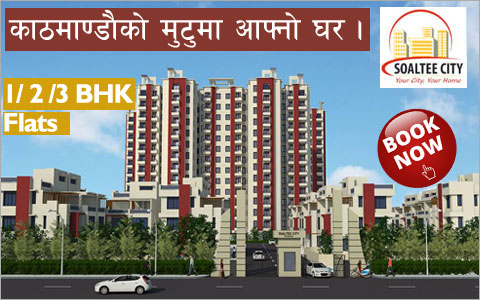National News

The overall land and house registration revenue collection in the first quarter of this fiscal year increased by 35 per cent as compared to the fiscal year 2013-14. According to records maintained by the Department of Land Reform and Management (DoLRM), it has collected a total of Rs 1.963 billion revenue from across the country in this fiscal while it was confined to Rs 1.447 billion in the corresponding period of the last fiscal.
Out of 83 land revenue offices (LROs), Dillibazar topped the list with a collection of the highest amount of registration tax worth Rs 412 million. Manang managed to collect the lowest amount of revenue worth Rs 90,012 in the first three months of this fiscal year. The registration gain tax, which was confined to one to two per cent, is now 4.5 per cent.
Besides, Dillibazar, there are four other LROs in the valley. Chabahil stood second with revenue collection of Rs 241 million while Kalanki secured the third position with revenue collection of Rs 172 million. Similarly, Lalitpur and Bhaktapur follows on the list with revenue collection of Rs 171 million and Rs 95 million respectively. Reportedly, the hike in land price valuation from the beginning of this fiscal year has soared by 100 per cent or even more in semi urban areas like Sangla, Goldhunga, Tokha, Chandeshwori, Gongabu, Jitpur, Manmaiju, Dharmasthali, among others. Sunsari, Chitwan, Jhapa, Morang, Belbari, Makwanpur and Kaski are some other places where revenue collection is remarkable.
“Being the capital city, demand and price of land is high as compared to other parts of the country,” said Gopal Giri, Chief Land Revenue Officer of LRO, Dillibazar, adding that the office includes 29 wards out of 35 in the metropolis which bagged the highest rate of transactions. Citing that although land transactions have not increased significantly, he said, “The growth in revenue collection is the result of the recent appreciation in land price valuation.” According to him, the government has increased land valuation of different areas from 20 per cent up to 100 per cent depending upon the area and demand.
The government has set a target of collecting Rs 5.368 billion from land registration in this fiscal. In the last fiscal, the government collected Rs 7.813 billion in land registration fees against a target of Rs 4.505 billion. “The target we have set for this fiscal year is not so ambitious. If the current trend of revenue collection is something to go by, we are confident to exceed the target,” said Raju Basnet, Section Officer at DoLRM. “The realty sector is gradually recovering as genuine buyers are gaining confidence to invest on property,” he added. According to him, flexible monetary policy and accessible home loans with low interest rates encouraged buyers to own property. He informed that customers are shifting their choice of preference from core areas to the growing sub-urban areas.
At a time when the government claims to exceed the stipulated target for revenue collection, real estate developers opined that the increased registration gain tax has negatively affected the industry. “It is totally invalid to tag the government’s high revenue collection with more transactions in the realty sector,” said Ichachha Bahadur Wagle, Vice President of Nepal Land and Housing Developers Association. “The increased land price valuation and doubled registration gain tax contributed to rise in revenue collection,” he added.
Accusing that the hike in registration gain tax as unscientific, Wagle said, “It has become an unnecessary burden to the buyers which might negatively affect the real estate business.” He opined that the tax should be limited to 0.5 to one per cent. Citing that realty transactions did grow, he said, “We have witnessed 30 per cent growth in transactions as compared to the last fiscal.” He further said that improved cycle of realty sector, confidence of customers, secured investment and plan for regional development are contributing factors to uplift the transaction.
source:sujata awale,The himalayan times,29 nov 2014
- 9th Nepal Buildcon International Expo 2024
- Real Estate Expo 2023
- NRB raises housing loan limit to encourage home constructions
- Nepal Rastra Bank (NRB) Monetary Policy 2080-2081
- New Price of Land in Kathmandu Metropolitan City, Nepal
- Capital Gains Tax Rate on Real Estate Transactions in Nepal 2080-81 ( 2023/24 )
- Kathmandu metropolis implements free parking policy for commercial buildings and hospitals

![[X]](https://www.housingnepal.com/images/popup-close-button.png)












































































































































































































































































































































































































 Facebook
Facebook
 Delicious
Delicious
 Digg
Digg
 Reddit
Reddit
 Stumble Upon
Stumble Upon









